The Type 95 Ha-Go was the most widely-built Japanese tank of WWII. Several countries (France, China, North Korea) briefly operated small numbers of Ha-Gos during the immediate post-WWII period. Another operator was Thailand, where, for several years after the war, it was the country’s lone tank type.
 (Functional Type 95 Ha-Go tank of the Royal Thai Army in 2010.)
(Functional Type 95 Ha-Go tank of the Royal Thai Army in 2010.)
Description of the Type 95 Ha-Go
The Type 95 was designated by the year 2295 of the imperial calendar (1935) when it was approved for production. It remained in production until 1943, with about 2,300 being manufactured. The Ha-Go was designed and built by Mitsubishi, but five other companies also made them during WWII.
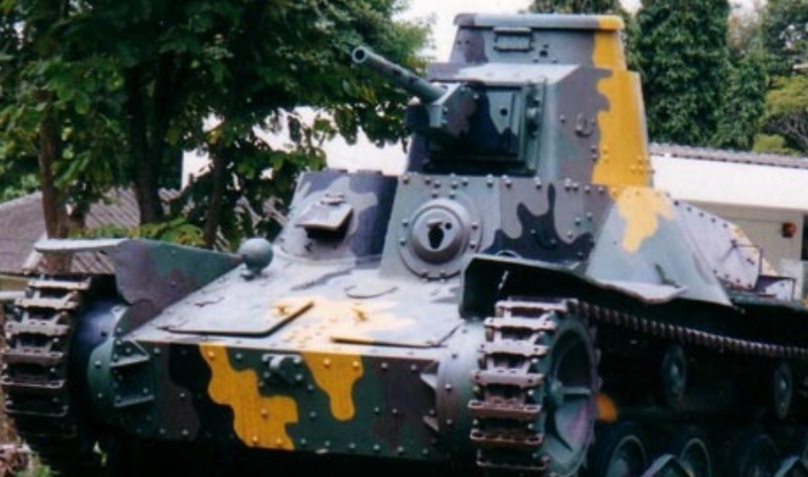 (A Thai Ha-Go preserved at RTA Lampang Barracks in the country’s north. This four-tone camouflage was used in the mid-1940s. The forward machine gun has been removed. As delivered to Thailand, the Ha-Gos had no headlights. The object in front of the driver’s position was a sort of rearwards light reflector intended to help the driver see by moonlight; it was not very successful.)
(A Thai Ha-Go preserved at RTA Lampang Barracks in the country’s north. This four-tone camouflage was used in the mid-1940s. The forward machine gun has been removed. As delivered to Thailand, the Ha-Gos had no headlights. The object in front of the driver’s position was a sort of rearwards light reflector intended to help the driver see by moonlight; it was not very successful.)
The Ha-Go weighed 7 ½ tons and measured 14’4″ long by 6’9″ wide by 7’2″ tall. It was powered by a Mitsubishi A6120VD diesel engine with manual transmission. It had a crew of three: the driver (in the hull on the right), the forward machine gunner (in the hull on the left), and the somewhat overworked commander in the cramped turret, who (besides directing the other two men) loaded, aimed, & fired the main gun, operated the rear machine gun, and searched for targets. The commander had no seat and had to stand the whole mission.
The turret was hand-cranked and limited to 45° movement. A bizarre feature was that the main Type 98 37mm gun was set in a moveable armor mantle. This moved ±10° up/down and ±10° left/right independently of the turret’s movement. There were no optics, the gun was aimed by peeping through a vision slit in the armor. The whole set-up was moved by a shoulder brace on the commander.
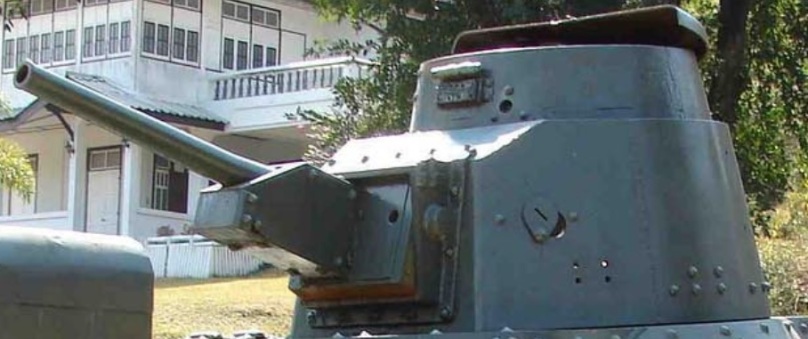 (Turret of a Ha-Go preserved at the Royal Thai Army’s Ft. Narai facility. This shows the moveable gun mantle, and also some of the vision slits. Many of these had moveable cover plates so that crewmen could fire handguns from inside the tank.)
(Turret of a Ha-Go preserved at the Royal Thai Army’s Ft. Narai facility. This shows the moveable gun mantle, and also some of the vision slits. Many of these had moveable cover plates so that crewmen could fire handguns from inside the tank.)
(Hulk of a Thai Ha-Go with the entire gun and mantle assembly removed, and the rear machine gun missing. This shows how cramped the little turret was.)
The hand-loaded Type 98 fired both HE and AP shells. The AP could penetrate 1 ½” of steel at 320 yards but the penetration fell off quickly after that. Since the Ha-Go lacked optics, further ranges were not very realistic anyways.
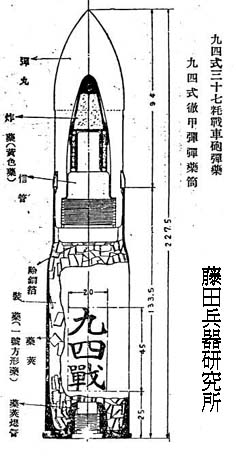 (Above: A dissected Type 95 tank gun captured by the US Army in WWII, and a diagram of it’s AP ammunition provided to the Thais by the Japanese during the war. The Ha-Go carried 75 rounds.)
(Above: A dissected Type 95 tank gun captured by the US Army in WWII, and a diagram of it’s AP ammunition provided to the Thais by the Japanese during the war. The Ha-Go carried 75 rounds.)
The secondary armament was two Type 97 machine guns, which fired the 7.7mm Arisaka cartridge from 20-round magazines. One was operated by the third crewman.
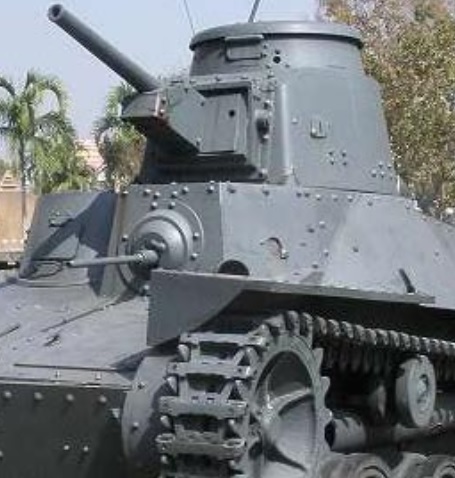 (A preserved Thai Ha-Go at Patham Tani, Thailand, showing the forwards machine gun.)
(A preserved Thai Ha-Go at Patham Tani, Thailand, showing the forwards machine gun.)
The other machine gun was set facing the rear of the tank, and was operated by the commander who had to turn around inside the turret to use it.
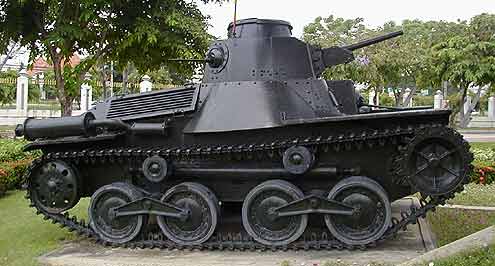 (A preserved Ha-Go in Thailand, showing the rear-facing machine gun and the suspension.)
(A preserved Ha-Go in Thailand, showing the rear-facing machine gun and the suspension.)
The suspension system was two simple bell cranks on each side, by which up/down motion of one linked wheel would result in forward/back movement of it’s partner. This crude set-up was not effective on rough ground. Another problem the Thais later told US Army advisers was that if the tank stopped suddenly, it would rock back and forth for several seconds making it hard to quickly aim. The tracks were 250mm wide and made of steel.
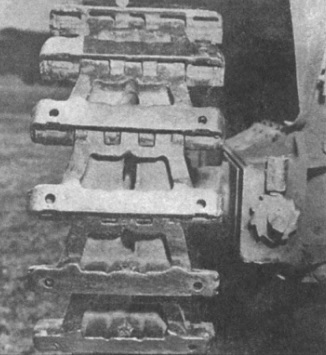 (The obsolete tread design of the Ha-Go.)
(The obsolete tread design of the Ha-Go.)
As designed, there was no radio. After WWII, the Thais added US Army-surplus walkie-talkies to some, but not all, of theirs. The Ha-Go had no headlights, however after WWII the Thais added a single headlight to theirs.
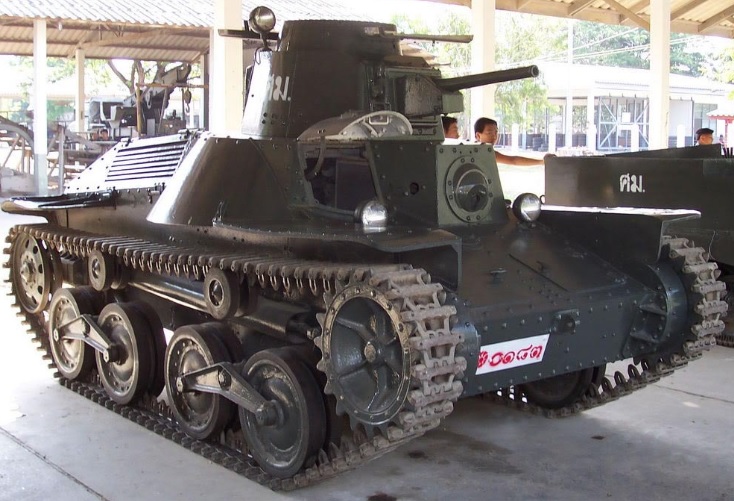 (Functional Ha-Go of the Royal Thai Army’s Ft Adison Cavalry Center at Saraburi, Thailand. It has three headlights fitted, initially the Thais only installed one headlight per tank.)
(Functional Ha-Go of the Royal Thai Army’s Ft Adison Cavalry Center at Saraburi, Thailand. It has three headlights fitted, initially the Thais only installed one headlight per tank.)
The Ha-Go comes to Thailand
In 1940, Thailand placed an order for fifty Ha-Gos, which it designated “Tank Type 83”. It is not entirely certain how many were actually delivered. The best guess is forty-eight, as that was the standard Thai tank unit size at the time. The Ha-Gos served alongside Vickers Mk.E tanks purchased from the UK. All of Thailand’s Ha-Gos had been delivered by the time Japan delivered it’s ultimatum to the Thai king on 8 December 1941. This resulted in a sort of semi-occupation of Thailand, with the country becoming a half-hearted ally of the Axis during WWII.
On 10 May 1942, the Thai army crossed the border of British Burma to occupy it’s state of Shan, which had been promised to Thailand by Japan after the planned victory in WWII. Most or all of Thailand’s Type 95s were deployed, as a special armored battalion of the 1st Cavalry Division. The addition was fortunate, as both cavalry regiments of the division suffered massive losses; not due to combat but rather jungle diseases affecting the horses which had been imported from Australia before WWII.
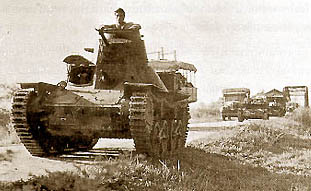 (A Thai Ha-Go on the move into Burma in 1942.)
(A Thai Ha-Go on the move into Burma in 1942.)
Because of the horse deaths, the tank battalion was transferred to the 2nd Infantry Division later in the war. The Ha-Gos did not suffer any losses in the Shan state operation. In 1944, the Ha-Gos were all recalled to Thailand.
By the summer of 1945, it was clear to most Thai people that Japan was going to lose WWII. That spring, the Japanese army had begun building a defensive line across Thailand’s interior (including a stretch just 50 miles north of Bangkok) signalling to the Thais that Japan intended to turn their country into a battlefield. The Thai army secretly planned a revolt against the Japanese, scheduled to take place in the autumn of 1945. The war ended before this could happen.
Thailand’s Ha-Gos after WWII
Thailand continued to use the Type 95 after WWII. In 1946, the Royal Thai Army was down-sized and reorganized. The Ha-Gos were reassigned to a special subunit of I Corps at Bangkok, with other even smaller detachments going elsewhere in the country.
During the war, the Thais had discovered the more unpleasant side of operating the Type 95. It was clearly not meant for long-duration operations. The concept of crewmen firing handguns through the vision slot shutters, which was taught by Japanese instructors, was shunned due to the severe noise inside the tank.
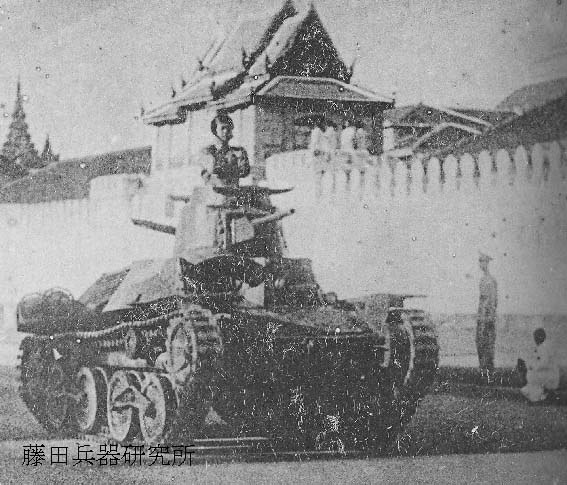 (A Ha-Go in Bangkok in the mid-1940s.)
(A Ha-Go in Bangkok in the mid-1940s.)
In the period just before the Korean War, US Army advisers began helping Thailand modernize it’s army. The Americans shared some disturbing facts of the Ha-Go discovered fighting them on the islands of the Pacific.
Advisers from the USA told the Thais that the Type 95’s armor (which was at best only 12mm and even thinner in places) was insufficient against the M4 Sherman or any other tank the USA intended to operate in the postwar US Army. It was also insufficient against the then-new M20 Super Bazooka. Furthermore, the Americans shared that during WWII, the 50BMG cartridge of the M2 Browning .50cal machine gun had penetrated Ha-Gos at close ranges. The Ha-Go would also be vulnerable to the Soviet T-34 tank, and most likely to the DShK 12.7mm heavy machine gun already being transferred to communist armies around the world. At certain points at close range, the then-new AK-47 assault rifle would be able to penetrate it as well.
During the war, the Americans discovered that the engine’s air intake was vulnerable to incendiary weapons, and also the bell-crank suspension would be destroyed by mines which would otherwise just throw a track on other tank types. Other shortcomings were in the area of tactics; both in Europe and in Asia, the US Army determined that the advantage lied with the tank which fired first and/or scored the first hit. The low accuracy and short range of the Ha-Go’s gun made this unlikely.
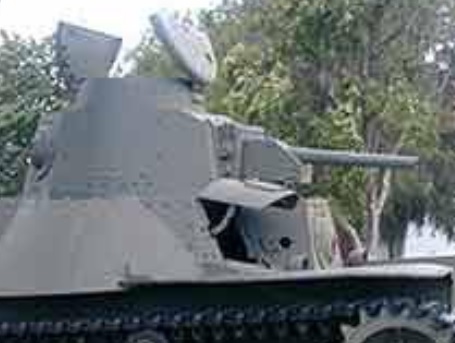 (A Ha-Go at Thailand’s Special Operations Centre at Ft Narai, showing the commander’s butterfly hatch open. There are several Type 95s preserved at Ft Narai today, so Thailand’s secretive specops commandos may have used them, perhaps as OPFOR trainers, past the official withdrawal date – maybe even up until around 1959-1960.)
(A Ha-Go at Thailand’s Special Operations Centre at Ft Narai, showing the commander’s butterfly hatch open. There are several Type 95s preserved at Ft Narai today, so Thailand’s secretive specops commandos may have used them, perhaps as OPFOR trainers, past the official withdrawal date – maybe even up until around 1959-1960.)
Because of this, Thailand began to rethink it’s decision to retain the Type 95s. Another problem was ammunition; obviously no more Type 98 37mm rounds would ever be made, and the Arisaka cartridges for the machine guns were also needed by Thai infantry.
Thailand did not deploy any of it’s Type 95s to it’s Korean War detachment. In 1952, the Royal Thai Army began phasing this tank out, a process completed by the beginning of 1954.
Today, seven of these tanks are preserved as monuments in Thailand.
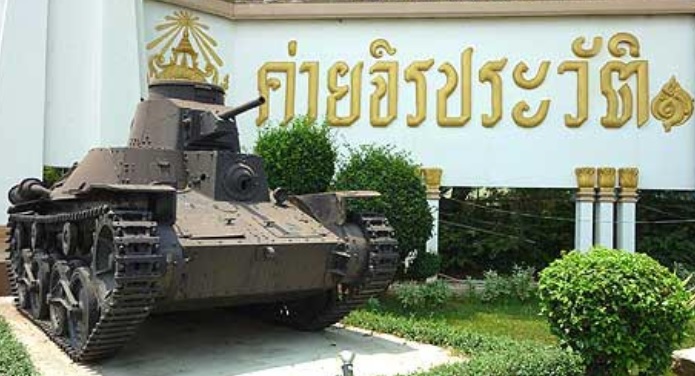 (A Ha-Go at the gate of RTA Nakhon Sawon Barracks in 2015.)
(A Ha-Go at the gate of RTA Nakhon Sawon Barracks in 2015.)
(Probably the most historically-inaccurate painting of any WWII relic of any type, anywhere……a preserved Ha-Go in Thailand, wearing 21st century digicam disruptive camouflage.)
Additionally, one is still in inventory with the Royal Thai Army. Based at the Cavalry Center in Saraburi, this Ha-Go is fully operational and the Thai army sometimes operates it for parades or ceremonial events. This is one of two Type 95s in the world that can still be driven under it’s own power, and the only one with fully-authentic equipment. It is also the last WWII Japanese-made tank still on official inventory in any of the world’s armies. Below is the Ha-Go being driven by a Thai soldier in 2010.

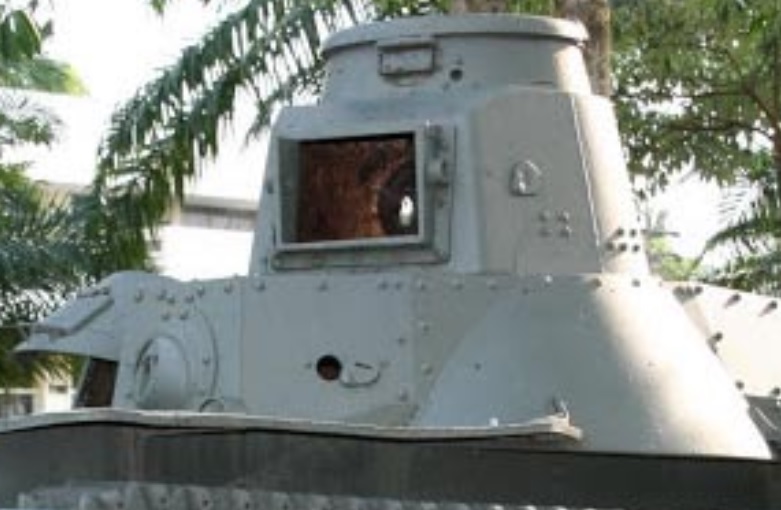
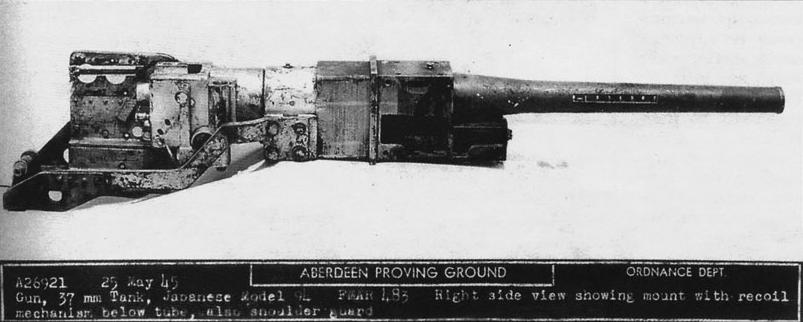
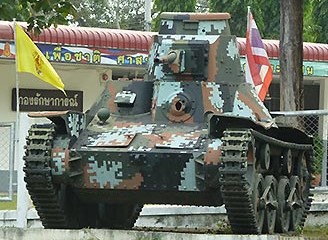
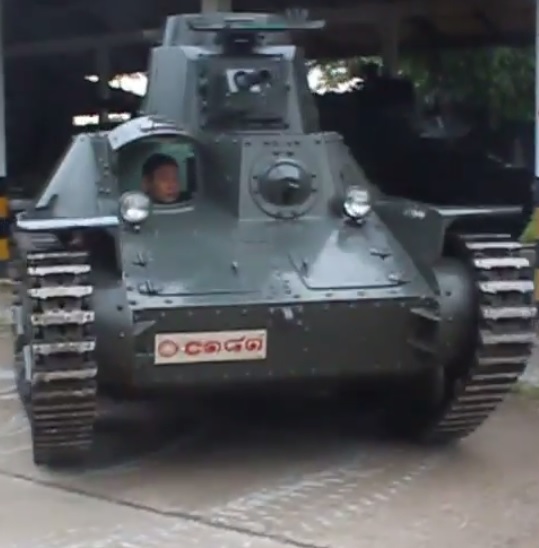
Reblogged this on Brittius.
LikeLike
[…] https://wwiiafterwwii.wordpress.com/2015/07/06/type-95-ha-go-in-thailand/#comments […]
LikeLike
The object in front of driver’s position is actually the original Japanese headlight that can be turned rearwards to avoid damage. Many photos have shown this trait
LikeLike
When I was writing this last year I originally thought the same thing. A person I know stationed at Rock island Arsenal (also interested in military history) said he thought it was a device designated (I believe, might be mistaken) Type 1 Model 1. he explained it was like a paired set of mirrors which amplified natural background light. I was only able to find one photograph of the thing I believe he was describing and it was very blurry, but, appeared the same shape in the same position. I guess it might be either, I was hoping to find a close-up of this particular tank but no luck so far.
LikeLike
[…] of Thailand. Osprey Publishing, New Vanguard #137: Japanese Tanks 1939-1945 (For info on the Ha-Go) An article about the Ha-Go in Thai service Our article on the Type 95 […]
LikeLiked by 1 person